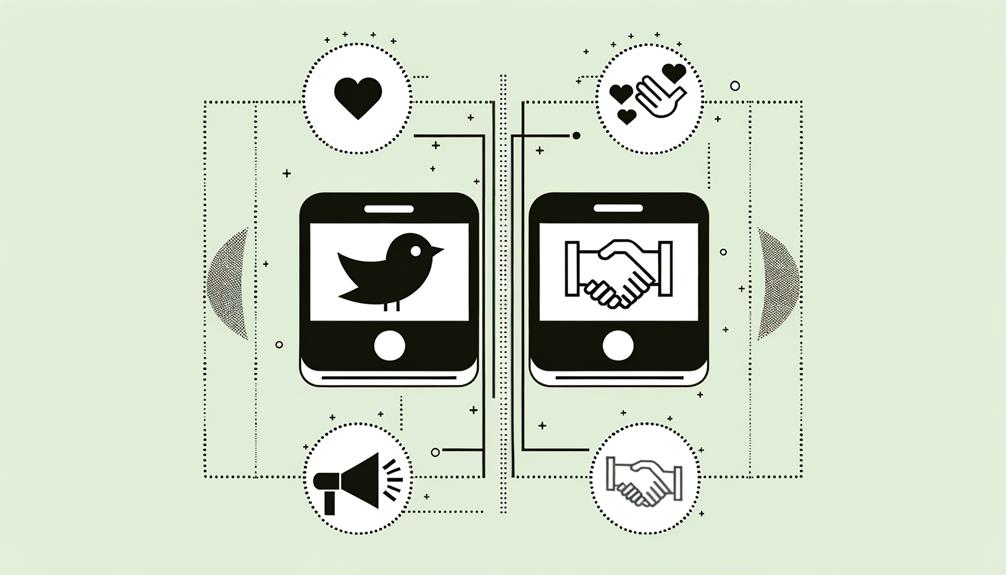No products in the cart.
Diving into the world of Twitter influencer campaigns without measuring success is like setting sail without a compass; you might move forward, but you’ll be unsure of your direction.
You’ve invested time and resources into these campaigns, so it’s only logical to track their performance. By identifying key performance indicators and analyzing metrics such as engagement and conversions, you gain invaluable insights.
This not only helps in evaluating the effectiveness of your current strategy but also in fine-tuning your approach for future initiatives. Let’s explore how this process can transform your marketing efforts, leaving you equipped for more informed decision-making.
Contents
hide
Key Takeaways
- Measuring success identifies the impact of influencer collaborations on brand awareness and audience engagement.
- Tracking metrics like engagement rates and conversions guides strategic decisions for future campaigns.
- Analyzing data enables brands to tailor content, ensuring relevance and maximizing audience resonance.
- Utilizing social listening tools offers insights into audience sentiment, enhancing the effectiveness of influencer partnerships.
Setting Campaign Objectives
To effectively steer a Twitter influencer campaign, it’s vital to set clear, strategic objectives that will serve as a roadmap for success. By defining specific goals, you’re not just shooting arrows in the dark; you’re targeting demographics with precision, ensuring every effort is aligned with your desired outcomes. It’s about understanding your audience intimately and setting benchmarks that reflect both their interests and your brand’s aspirations.
Crafting these objectives requires a delicate balance between ambition and realism. It’s not merely about stating what you wish to achieve but embedding these goals within the fabric of data-driven decision-making. This process enables you to tailor your strategies, ensuring they resonate with your target demographic. As you dive into the nitty-gritty of your campaign, remember that these objectives are your north star, guiding every tweet, collaboration, and content piece.
Identifying Key Performance Indicators
After establishing clear objectives for your Twitter influencer campaign, it’s critical to identify Key Performance Indicators (KPIs) that will accurately measure your success. KPIs are the backbone of performance evaluation, offering a quantifiable means to assess how well your campaign aligns with your strategic goals. By focusing on metrics like engagement, reach, and conversions, you’re equipped with the data to make informed decisions.
Analyzing metrics such as click-through rates, follower growth, and sentiment analysis not only provides insight into the effectiveness of your campaign strategy but also ensures that every move you make is data-driven. This approach facilitates continuous optimization, allowing you to tweak and refine your strategy for maximum impact.
Moreover, clear KPIs serve as a compass in the vast sea of social media metrics, guiding you towards the most relevant data for assessing your campaign’s impact on brand awareness, audience engagement, and overall ROI. By identifying and monitoring the right KPIs, you’re not just evaluating performance; you’re paving the way for innovative strategies that align with your business objectives and drive success.
Selecting Relevant Metrics
As you embark on measuring the success of your Twitter influencer campaigns, it’s crucial to carefully select metrics that align with your strategic goals. Analyzing engagement rates not only sheds light on how your content resonates with the audience but also highlights areas for improvement.
Furthermore, tracking conversion impact provides concrete evidence of the campaign’s ROI, guiding future marketing decisions.
Identifying Key Performance Indicators
Identifying the right Key Performance Indicators (KPIs) is fundamental in evaluating the success of your Twitter influencer campaigns, guiding strategic decisions with precision. It’s not just about choosing any metrics but selecting those aligned with your campaign objectives. This means focusing on influencer selection and setting clear performance benchmarks. These KPIs become your north star, directing every step of the campaign from inception to conclusion.
Understanding and interpreting the data these KPIs provide is crucial for campaign optimization. It’s not just about collecting numbers but analyzing them to glean actionable insights. This process of data interpretation ensures that your strategy remains agile, adapting to both the successes and the challenges. By meticulously tracking specific KPIs, you’re not just running a campaign; you’re optimizing it in real-time, ensuring that your influencer partnerships deliver maximum impact.
Analyzing Engagement Rates
Measuring engagement rates is key to unlocking insights into how effectively your influencer content resonates with its intended audience. By focusing on likes, comments, shares, and clicks, you’re able to gauge the depth of audience engagement and content relevance. High engagement rates often signal a strong follower interaction and campaign resonance, indicating your message is not just seen but felt.
| Metric | Purpose | Impact on Strategy |
|---|---|---|
| Likes | Gauge initial interest | Assess content appeal |
| Comments | Measure active engagement & feedback | Refine messaging |
| Shares | Indicate content relevance & resonance | Expand reach |
| Clicks | Track action-oriented engagement | Drive conversions |
| Engagement Rate | Overall campaign effectiveness | Strategic adjustments |
Analyzing these metrics strategically offers invaluable insights, steering your campaign towards innovation and enhanced performance.
Tracking Conversion Impact
To maximize your campaign’s ROI, it’s critical to track conversion impact through metrics such as click-through and conversion rates. These figures aren’t just numbers; they’re signposts guiding you through the murky waters of audience behavior.
By diving deep into conversion analysis, you unlock the story behind each click, each purchase. It’s this granular understanding that empowers you to make strategic decisions, tailoring your approach for maximum resonance.
Moreover, these metrics serve as the backbone for campaign optimization. With each insight, you’re not just iterating; you’re innovating, shaping your strategies to meet your audience where they are. This isn’t about guesswork; it’s about informed decision-making, ensuring every tweet, every influencer collaboration, is a step towards achieving your marketing zenith.
Analyzing Engagement Rates
Analyzing engagement rates is crucial for understanding how well your audience connects with influencer content on Twitter. These metrics serve as a direct line to gauging the resonance of your campaigns with your target demographic. By delving into how individuals interact with posts, you’re equipped to tailor future strategies for heightened effectiveness. This isn’t just about counting likes; it’s about interpreting what those likes mean for audience engagement and influencer impact.
Consider these factors to paint a comprehensive picture:
- Likes and retweets: Indicative of content’s immediate appeal and shareability.
- Replies: Reflect the depth of conversation and connection with the audience.
- Engagement rate trends: Show how interest in content fluctuates with changing trends.
- Content optimization: Guides adjustments for improved engagement based on feedback.
- Influencer impact: Measures how influencer credibility boosts or detracts from engagement levels.
High engagement rates are a testament to active audience participation and a keen interest in the influencer’s content. Through strategic analysis and adjustment, you can harness these insights to not just chase trending topics, but to truly resonate with your audience, ensuring that every tweet moves you closer to your campaign goals.
Assessing Reach and Impressions
Understanding the reach and impressions of your Twitter influencer campaigns is crucial for gauging their overall visibility and potential impact on your target audience. Reach, indicating the total number of unique users who see your campaign content, and impressions, representing the number of times that content is displayed, are key metrics in this assessment. By tracking these metrics, you’re not just counting views; you’re diving deep into the campaign’s ability to penetrate your desired market segment.
Analyzing reach and impressions offers a clear window into the effectiveness of your Twitter influencer collaborations. It’s not merely about the volume but the quality of exposure. Audience demographics and engagement levels come into play, revealing whether your message is resonating with the intended crowd or merely passing through their feeds. This analysis provides actionable insights, allowing you to refine your strategies for higher engagement and better targeting.
Moreover, understanding content reach and its viral potential can be transformative. It’s about identifying what content captures the audience’s imagination and why. This insight is invaluable for innovating future campaigns, ensuring they’re not just seen but remembered and acted upon, driving your brand’s message further into the consciousness of your target demographic.
Evaluating Sales Impact
Evaluating the sales impact of your Twitter influencer campaigns is a critical step in understanding their true value to your brand’s bottom line. By focusing on revenue evaluation and sales optimization, you’re not just seeing numbers; you’re gaining insights into the influencer impact and the overall ROI analysis of your strategies. This deep dive allows you to iterate and refine, ensuring each campaign is more effective than the last.
To paint a clearer picture, consider these key actions:
- Monitoring sales and revenue effects to grasp the full extent of your campaign’s influence.
- Determining ROI through sales data, which aids in precise decision-making for future influencer partnerships.
- Identifying areas for revenue improvement to continually optimize campaign performance.
- Utilizing custom coupon codes and product-focused contests, proven methods to drive sales and deepen engagement.
- Launching special promotions and discounts during influencer collaborations, significantly elevating sales figures and brand visibility.
Measuring Brand Awareness
To effectively measure brand awareness in your Twitter influencer campaigns, you need to focus on tracking mentions and hashtags.
Analyzing engagement rates further reveals the impact of these campaigns on your audience’s recognition and interest in your brand.
This strategic approach allows you to quantify brand visibility and tailor your strategies for enhanced audience engagement.
Tracking Mentions & Hashtags
In the dynamic landscape of Twitter, monitoring brand mentions and hashtags is a critical strategy for assessing your brand’s awareness and engagement levels. By diving into the analytics, you can unlock valuable insights that steer your brand towards innovation and impact.
- Sentiment analysis helps decipher the emotions behind the mentions, offering a deeper understanding of public perception.
- Trend analysis identifies emerging conversations, positioning your brand at the forefront of relevant discussions.
Utilizing Twitter Analytics enhances precision in tracking your brand’s online footprint. Analyzing the frequency of mentions reveals the ebb and flow of brand relevance. Tracking branded hashtag performance measures the direct impact of your campaigns.
Harness these strategies to refine your approach, ensuring your brand not only resonates but thrives in the ever-evolving digital dialogue.
Analyzing Engagement Rates
Understanding engagement rates on Twitter gives you a clear picture of how effectively your audience interacts with your brand’s content, highlighting the vitality of these metrics in measuring brand awareness.
High engagement rates aren’t just numbers; they’re indicators of increased visibility and a testament to a successful content strategy.
By diving into Twitter analytics, you’re equipped to assess the impact of influencer partnerships, understanding which collaborations are truly resonating with your audience.
Tracking likes, comments, and shares isn’t just about counting interactions—it’s about gauging genuine interest and involvement.
This strategic analysis leads to enhanced content strategies, fostering a stronger brand presence.
Ultimately, prioritizing audience engagement through thoughtful influencer partnerships amplifies your brand’s voice, ensuring it’s heard across the vast Twitter landscape.
Utilizing Social Listening Tools
Harnessing the power of social listening tools can significantly boost the effectiveness of your Twitter influencer campaigns. By tapping into the vast sea of real-time conversations and data, you’re equipped to make informed strategic decisions that propel your campaigns forward.
Utilizing social listening tools allows you to:
- Measure audience sentiment, gauging the emotional response toward your brand and campaign.
- Conduct competitor analysis to benchmark your performance and uncover areas for improvement.
- Identify and ride the wave of trend analysis, ensuring your content remains relevant and engaging.
- Monitor content performance, understanding what resonates with your audience and why.
- Track mentions, hashtags, and keywords, offering a comprehensive view of your campaign’s reach and impact.
Adjusting Strategy Based on Data
Analyzing data from your Twitter influencer campaigns allows you to make strategic adjustments that can significantly improve their effectiveness. By focusing on data points like engagement rates, reach, and conversions, you’re equipped to make informed, data-driven decisions. This approach to strategy refinement isn’t just about tweaking what doesn’t work; it’s about amplifying what does, ensuring every move you make is calculated and impactful.
The insights gained from tracking audience response and performance metrics are invaluable. They guide you in making real-time adjustments, a crucial aspect of campaign optimization. In the fast-paced world of Twitter, the ability to pivot quickly based on solid data can set your campaign apart from the rest.
Utilizing these data-driven insights for real-time adjustments doesn’t just enhance campaign results—it revolutionizes them. Monitoring key performance indicators (KPIs) enables you to make strategic changes that lead to better outcomes. This isn’t just about running a campaign; it’s about mastering the art of adaptation and optimization.
In essence, the power lies in your hands to transform your Twitter influencer campaigns into dynamic, high-performing assets that resonate with your audience and exceed your goals. Make every decision count, and let data be your guide to success.
Frequently Asked Questions
How Do You Measure the Success of an Influencer Campaign?
You measure an influencer campaign’s success by tracking audience growth, analyzing brand sentiment, and leveraging metrics like engagement and conversions. This strategic approach offers deep insights, guiding innovative strategies for future campaigns.
What Makes a Successful Influencer Campaign?
A successful influencer campaign hinges on brand alignment and audience engagement. You’ll achieve lasting results by tailoring strategies to your target demographic, ensuring your message resonates and drives innovative, engaging interactions with your audience.
How Do You Measure the Impact of Influencer Marketing?
You’ll measure the impact of influencer marketing by tracking audience sentiment and the quality of engagement. Analyze likes, comments, and shares to gauge how well your content resonates, ensuring your strategy aligns with innovation.
What Are the Key Performance Indicators of Influencer Marketing?
You’ll find audience engagement and content quality as key performance indicators in influencer marketing. Analyzing these metrics offers strategic insights into how effectively influencers connect with and impact their audiences, guiding innovative marketing decisions.
Conclusion
In sum, measuring success in Twitter influencer campaigns is vital for refining your marketing strategies. By setting clear objectives, identifying KPIs, and tracking relevant metrics, you’ll gain invaluable insights into your campaign’s performance.
Analyzing engagement, reach, and sales impact enables you to understand the true influence on your audience. Utilizing social listening tools and adjusting your strategy based on data ensures your campaigns are optimized for maximum impact.
It’s a strategic approach to guarantee your marketing efforts aren’t just seen, but felt.






